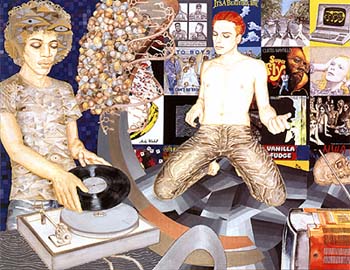 Abetz / Drescher - Electric Ladyland (Click here for English text) Aufsehen erregten Maike Abetz und Oliver Drescher durch ihre erste Ausstellung "Up against it" 1996/97 in Berlin, in der sie Gemälde, Aquarelle und Plattencover auf einer Op-Art-Tapete zur Rauminstallation kombinierten. In ihrer ersten Einzelausstellung bei arsFutura verzichten sie nun auf das Environment und nehmen diese Bezüge zugunsten der Komplexität ihrer Malerei in ihr Bildvokabular auf. Abetz / Dreschers grossformatige Gemälde zeigen den oder die Dargestellten in einem mit verschiedensten Accessoires ausgestatteten Umraum. Seit Beginn des 16. Jahrhunderts sind diese Bildnisse eine Form der Menschendarstellung, die in der Renaissance eine erste Blüte erlebt hat und sich von da an neben dem Bildnis vor neutralem Grund konsequent behauptet. Die Kryptoportraits beider oder eines der beiden Künstler sind eine Aktualisierung dieses Themas: In der Darstellung der Körper legen Abetz / Drescher Wert auf eine eigendefinierte Form von Körperlichkeit: Androgynität, oder die ornamentale Gestaltung des Körperinnern wie auch die Körperhaltung (Posen bekannter Popstars) deuten auf die Auflösung von Identität(en), die Auflösung von Differenzen. Hintergrundstrukturen wie Wellenformen, Mosaik- und Op-Art-Muster verbinden die einzelnen Bildelemente und sind zugleich verantwortlich für die Auflösung einer wirklichkeitsnahen Raumordnung. Ein synästhetischer Raum entsteht, dessen Medium Musik zu sein scheint. Die lasierende Malweise und die spezifische Rhythmisierung der Bilder durch klar abgegrenzte Flächen oder Motive wird als Übersetzungsmöglichkeit begriffen, um die differente raumzeitliche Dimension von Musik visuell erfahrbar zu machen. Abetz / Drescher, die beide zur ersten Fernsehgeneration gehören, reflektieren die medientechnologische Entwicklung und die damit verbundene Geschichte der Kunst des 20. Jahrhunderts. Ihre Images und das damit einhergehende Lebensgefühl sind an die entsprechende Technologie dieser Zeit gekoppelt: die Schallplatte als Speichermedium, das Fernsehgerät und analoge Aufzeichnungsmedien wie das Tonband wirken wie ein Epitaph auf die analogen Medien. Die digitalisierte Verfügbarkeit über Referenzsysteme jedoch ist der Grund, die Körper leer zu machen, im Arbeitsdialog zu verschmelzen und "Objekten" im Prozess des Malens wieder Aura zu verleihen. Malerei ist für Maike Abetz und Oliver Drescher das Medium, die Welt zu resymbolisieren. "Es ist bewiesen, dass Malerei klingen kann." Textauszug: Heike Föll, Kraftwerk Berlin, Aarhus Kunstmuseum, 28. August – 26. September 1999, S.49 Ausstellungsdauer: 25.3. - 13.5.2000 Oeffnungszeiten: Di-Fr 13-18 Uhr, Sa 12-16 Uhr Galerie ars futura Bleicherweg 45 8002 Zürich Telefon: 01-201 88 10 Fax: 01-201 88 11 E-Mail: arsfutura@bluewin.ch www.arsfutura.ch Abetz / Drescher - Electric Ladyland Maike Abetz and Oliver Drescher had a fulminant start with their first solo show "Up against it" 1996/97 in Berlin, where they arranged paintings, aquarels and covers of old records on an Op-Art-wallpaper. Several international shows in Germany, Austria and America followed. Now with their first solo show at arsFutura they have abandoned the environment in favour of an integration of this vocabulary into the complexity of their paintings. Abetz / Dreschers’ large paintings combine portraits of themselves, of popstars or friends with a room full of accessories. This type of portrait is known since the 16th century and had its first prime-time in the Renaissance. Next to the portrait on neutral background it has remained in the iconographic vocabulary of art until today. The cryptoportraits of Maike Abetz and Oliver Drescher actualize this theme: In their portrayal of the body the two artists focus on a self-defined form of corporeality: Androgynity, posture (the pop-star-pose) or the ornamental arrangement of the body signify the disintegration of identities, the abolition of differences. Background-structures such as mosaics, wave-like shapes and Op-art patterns bridge the different elements and are at the same time responsible for the dissolution of real space. A synaesthetic room is created whose medium appears to be music. The specific type of varnish and the rhythm of the paintings, contrived by way of distinguished areas or motives, are means to experience the time – space dimension of music on a visual level. Abetz / Drescher, who both belong to the first TV-generation, reflect the technological development of the media and its corresponding iconography in 20th century arts. Their images and the lifestyle related to this development are bound to the technologies of their time: Records, television or analogical recording-technologies like the taperecorder appear as an epitaph of the analogous media. The digitalized availability of references on the other hand is the reason to empty the bodies, to dissolve in the dialogue of the work and to enhance "objecs" with an aura during the process of painting. Painting is the means to resymbolize the world. "It is proved that painting is able to sound". Excerpt from: Heike Föll, Kraftwerk Berlin, Aarhus Kunstmuseum, 28.August – 26. September 1999, S.49 Translation: Kathrin Herzog |